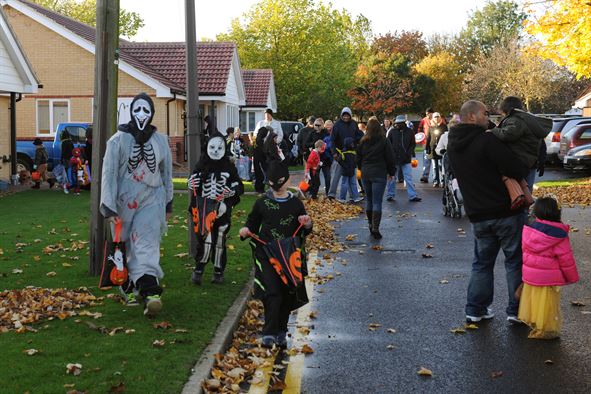
Trigger warning — for those who are triggered by statements without solid data!
Trick-or-treating, it seems, is dead.
I offer two pieces of evidence: first, we had about half a dozen trick-or-treaters at our door last night, and, of these, two were families we knew personally and one was my son and his friends. We didn’t even get any of the usual after-dark teenagers, except, again, for my son and his friends. (Yes, they did have costumes – my son dug out his 7th grade costume, though he’s grown quite a bit since then! — and you know what? I’ve gotten used to teen trick-or-treaters enjoying themselves, so long as they put on a costume.)
Second, the Washington Post had an opinion piece called “Let your kids go trick-or-treating. It’s good for them.” which is meant to encourage parents whose version of trick-or-treating for their children, has become the “trunk or treat” program sponsored by their local church or town. The author talks about the life lessons learned in trick-or-treating, that is, the need to go up to strangers to ask for the treat, then say thank-you afterwards, and the opportunity, at the right age, to do so with friends instead of family.
One presumes that the author wouldn’t be writing this unless there was a need.
Can I find concrete evidence that the percentage of children who trick-or-treat has declined; or that fewer of the tween-aged kids are allowed to go on their own, or that families restrict themselves; or kids are restricted by Mom & Dad, to just the houses on their own block or other “safe” houses; or that, because Mom & Dad are supervising, they only get to hit a few houses before they rustle up the kids to go home; or that the prevalence of trunk-or-treat and school Halloween parties means that the kids just lose interest sooner because they have too much candy already? No. The National Retail Federation is more interested in total spend, e.g., on costumes and candy, and not in the manner in which the candy is distributed or costumes are used. They do report that 30.8% of adults surveyed planned to take children trick-or-treating, vs. 32.9% in 2011 (the first year for which data was available from their survey online), but if this survey category included “take children trunk-or-treating” as well, for instance, it wouldn’t show any real changes, and it’s likewise unclear whether this would capture parents of children who go out by themselves.
So, yes, it was a cold night last night, but that’s to be expected for Halloween, isn’t it? And we’ve never had particularly many trick-or-treaters; there seems to be something about how our street lands, in terms of Halloween traffic patterns, that means that neighboring streets get more. But it’ll be quite the challenge to avoid gaining weight from this year’s leftover candy.
Anyway, I don’t have a grand reflection on what this means. Maybe it means nothing, and it’s just a fluke and everyone else was running out of candy. Even if not, will it harm kids to lose the trick-or-treat tradition? Not in isolation — only to the extent that this is one piece of larger social trends in which children and teens are becoming homebodies unprepared to start the process of adulting.
Image: http://www.501csw.usafe.af.mil/News/Article-Display/Article/436731/trick-or-treaters-converge-on-raf-alconbury/













